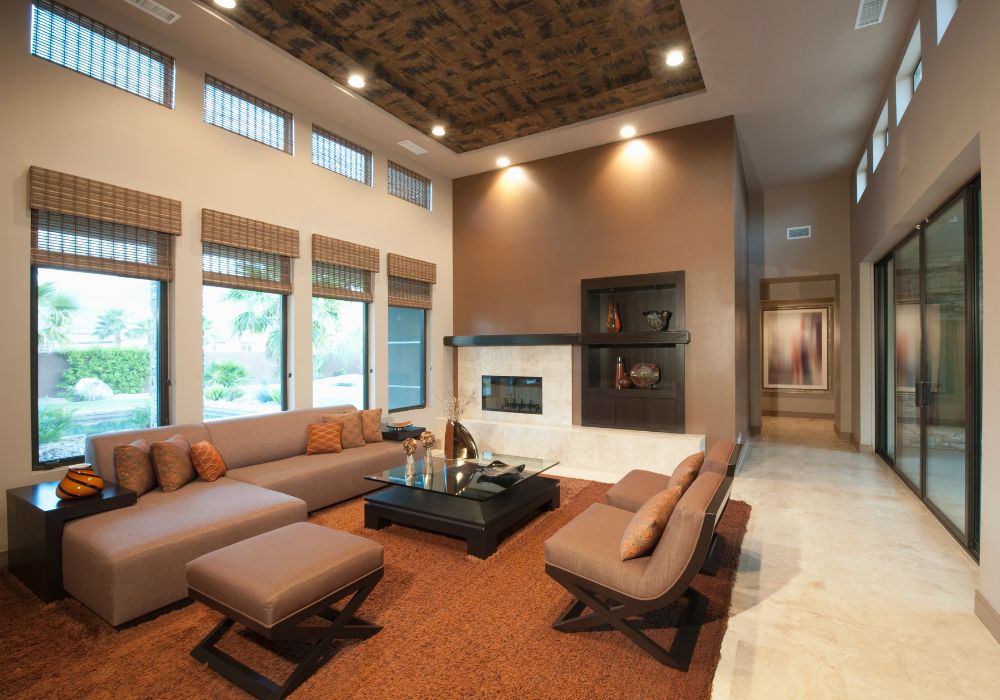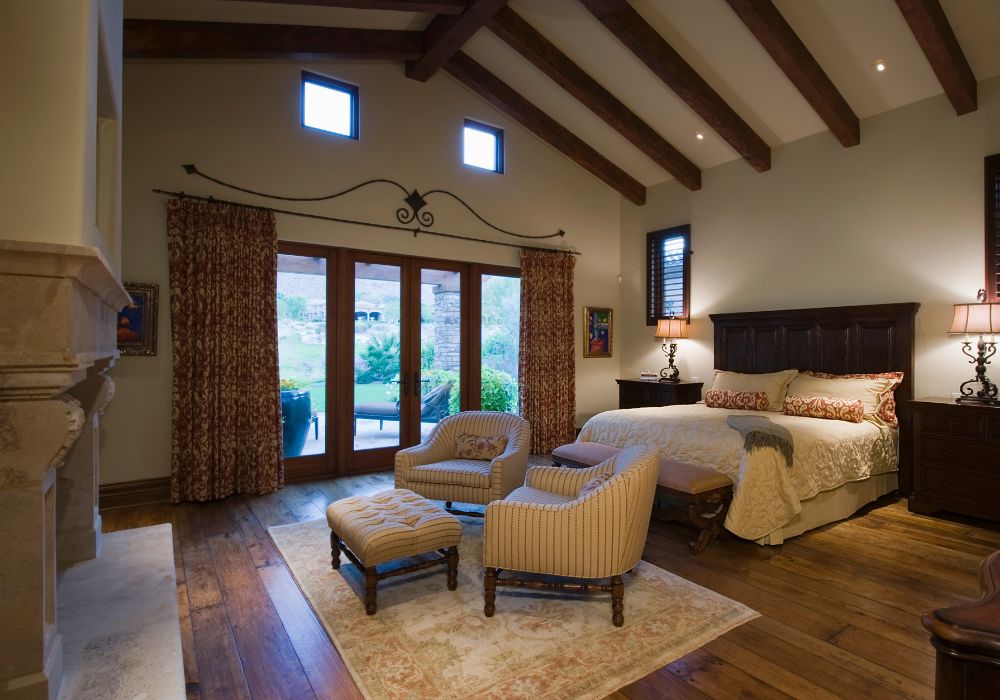If you’re going to build a house, build it right. Although this might sound cliche, it’s more than just the basics.
The ceiling height plays the most crucial role in your home. Homeowners use it to add interest to the space or as an accent.
Just like any other part of the room, you need to find out what works best for you and your family.
If you’re looking for a standard ceiling height for your living room, you’ve come to the right place! We will show you all the options that are available out there!
Generally, the ideal ceiling height for living rooms is 8 feet or 96 inches. This statement comes from the National Building Code (NBC). At the same time, the bare minimum height for a room with suspended ceilings is 7 feet and 5 inches.
Nonetheless, it is not uncommon to come across rooms with ceilings as high as 9 or 10 feet these days.
What’s The Standard Ceiling Height For Living Rooms?

Most cases, the standard ceiling height for living rooms is 8 feet or 96 inches. This is by the National Building Code (NBC).
Currently, the typical ceiling height in modern residential houses is 9 feet.
First-floor ceiling heights in modern homes are typically nine feet. Then sometimes, eight-foot ceilings on the second story.
Living Room
The living room is the central gathering place in a house, where people gather to socialize, read, or watch TV. If you’re a homebody, you probably never leave the living room. Other names for a living space include a lounge, sitting room, front room, and parlor.
Historic Belief
Historically, as homes began to be mass-produced, lower ceilings became the standard. However, contractors and designers generally disapproved of constructing buildings with higher ceilings. They see them as unnecessary and inefficient.
Over time, the eight-foot dimension became the standard. They achieved this by layering two drywall panels, each four feet wide. Then on top of one another, placed horizontally.
Modernization
However, it all comes down to the space’s dimensions and the arrangement of the furniture. It also depends on the home’s architectural style in determining the ideal ceiling. The space feels warm and inviting when the ceiling is low, whereas it feels more open and large when it’s high.
Do Ceiling Height Matters?

Yes, ceiling height matters. Properties with high ceilings contribute to the building’s overall market worth. As you can see, there is an improvement in lifestyle when ceilings are high.
It makes you feel lighter because there is more space and air. Meanwhile, apartments with low ceilings make you feel a bit restrained.
Climates
High ceilings are helpful in warmer climates such as the tropics or the Mediterranean. This is because they enable the temperature of the airflow.
As a result, warmer air rises to the roof while cooler air circulates throughout the rest of the space.
High Ceiling Advantages
A high ceiling makes your house seem roomier. It increases a sense of space and provides fresh, rich air. Adding height to a room may make even a tiny space seem considerably larger.
High ceilings also benefit from installing stunning lighting fixtures like chandeliers.
Low Ceiling Advantages
With a low ceiling, you can reduce your energy costs for cooling and heating systems. In addition, it reduces the available volume for these systems to work well.
Since it is easier to heat smaller rooms, many farmhouses had ceilings no higher than seven feet.
Are 10-foot Ceilings Too High?
No, a 10 feet ceiling is not too high. But it’s ultimately a matter of personal taste. The ten-foot height of the ceiling makes the room feel much larger and grander.
For instance, doors and windows must be at least 8 feet high if the wall height is 10 feet. Otherwise, the doors and windows will look too small. Combining features like vaulted and coffered ceilings gives you the best of both worlds.
Yet, having a higher ceiling height can counteract the effect of a huge crowning. Huge displays can make a space seem lower in height.
Before Installation
If you plan to install a 10-foot ceiling, consider how the height makes you feel. Research shows that children living in homes with higher ceilings experience a sense of being small. They also feel inadequate and overwhelmed.
Having said that, there is an added expense of enclosing 10-foot-high ceilings. Additionally, you should consider the heating and cooling of the space. This can lead to pretty costly construction.
Above all, there is no universally best ceiling height. Instead, you must evaluate each situation on its own merits.
Are 12-foot Ceilings Too High?
Don’t worry; a ceiling height of 12 feet is just fine. However, the ideal ceiling height depends on the room’s function and proportions.
Well, 12-foot ceilings are what you’re looking for in your home if you have a spacious mansion. Grand rooms, foyers, and dining rooms may require lighting and windows.
Other decorative ceiling moldings can add to the huge space as well. However, remember that the room may look off without furniture, windows, or lights.
In particular, the typical height of a ceiling is 8 feet. However, a living room can have one as high as 12 feet if desired. Renovated loft apartments and pre-war architectural architecture sometimes include 12-foot ceilings.
Selling A 12-foot Ceiling House
Most homes have ceilings that are 8 to 9 feet high. 10′ is generous. 12′ is luxurious. Your room size doesn’t have to match a certain ceiling height. However, building costs will go up if ceilings are higher.
Nonetheless, high ceilings are still more typical of luxury residences. This is true when you compare them with a cheaper or middle-class home. In the second case, it could be more challenging to sell to a buyer with a high ceiling.
Remember that high ceilings will increase a home’s value if you place it within a sophisticated neighborhood.
What Living Room Ceiling Height Is Too Low?

The minimum ceiling height could be up to 6.5 feet. However, if you have any less than this, it will be hard for you to move around the area.
If you want to know how high your ceiling is, you can use the distance between the ceiling joists and the floor as a guide. The acceptable height range for this area is between 6.5 and 7.2 feet.
But, if your ceiling height is lower than this, you should consult a professional. They will assist in raising the appropriate ceiling height.
Loft Conversion
Plan the loft conversion layout to use the lowest levels for storage or furniture. Then you could maximize the highest levels left open for access. Half the area should ideally have a ceiling height of 6.8 feet or above.
As you can see, having low ceilings aren’t necessarily a negative feature. In the first place, dropped ceilings are there to conceal the pipes. They are also ideal for wiring or ductwork in a building by forming a congested space above the ceiling.
Still, it provides easy access for maintenance and inspections. As a bonus, lower ceilings cover unsightly issues like water damage or sagging beams.
Do Tall Living Room Ceilings Add Value?

The answer is yes, high ceilings increase the value of a home.
If you’re looking to buy a house or move into a loft, your agent will emphasize the importance of a high ceiling to you. Several homebuyers are significantly interested in a higher ceiling level.
Consumers have been monitoring the costs associated with the luxury of 9, 10, foot ceilings. When extra height doesn’t increase the cost of rent, people prefer even 12-foot ones.
High Selling Point
If you plan on selling your property, you should highlight high ceilings as a selling point. It’s sure to impress potential buyers at the open house. Real estate professionals believe that properties with high ceilings sell faster. They assume that it is greater and can benefit higher rates.
Is a High Ceiling More Expensive?
Indeed, higher ceilings mean higher construction costs. It depends on the materials, but the answer is usually yes.
High ceilings require extra heat to warm a room with taller walls. Wallboard, primer, and paint are necessary, which adds to the price. Remember that associated costs are higher than a regular nine-foot ceiling.
As you can see, the estimated fees to increase the height of a normal ceiling by 11 or 12 feet can range from $18,000 to $25,000.
Even though higher ceilings lend an air of richness to any space, they can be a pain to keep clean. In addition, you should set aside more cash if the construction cost exceeds your budget.
Consider not only the initial investment but also the ongoing upkeep and maintenance. Also, keep in mind how to manage noise control and temperature regulation.
Ultimately, high ceilings continue to be more typical kinds of luxury homes.









